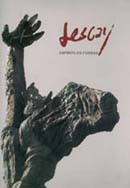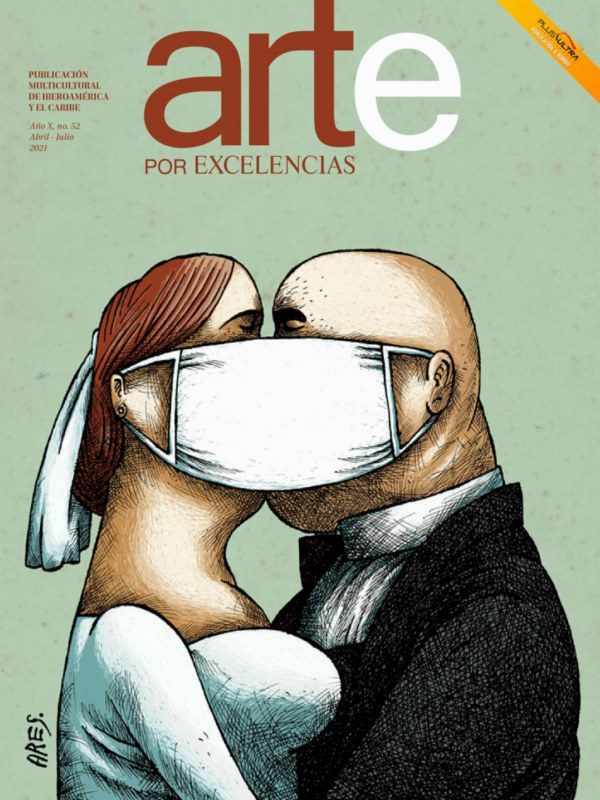I ignore whether curating a book –organize it, be responsible for all its images and vignettes, for all texts both critical and informative– may hamper someone from writing a review about it. I wonder so because that’s exactly what I’m doing right now and I don’t think it might be suitable to put an undeserved racket on this lovely volume. Since I believe the book came out right and I don’t dislike recalling everything we did –from a Cuban inland city– to piece together in a harmonious and logical publishing space the useful vision of the work by a writer who is alive and working restlessly, I’ll dare do this and let the chips fall where they may. Right out of the printing press of Mexico’s Santiago de Queretaro, “Lescay: Spirit in Forms” carries 177 pages that take readers on a grand tour around the work of Cuban fine artist Alberto Lescay Merencio. As we all know, Lescay’s artworks are committed to the discovery –and exposure- of the human being’s spiritual reality immerged in its materiality. It may sound somewhat gibberish if I put it like this, yet I just can’t find a better way to describe the relationship between This and The Other Side of people, things and historic processes. It’s just as if the Caribbean historical, political and cultural dialectics, as construed in this artist’s work, contained far more elements than those that are usually taken for granted, as if the spiritual mettle of each and every human individualities that there have been and there will be, will always remain in the foreground. A few years ago, I myself believed that Lescay’s works have departed from three initial moments –magic, Eros and flightto stretch out later on down a path that no one else other than the creator himself defined when he said, “I see the spirit and I try to show it.” That’s what this is all about: making it visible. And I say visible, something that can be pointed at with a finger, something colorful that can be described. In addition to his themes focused on the Congarooted spirituality of Cuban culture, Alberto Lescay Merencio’s works showcase personalized stylistic watermarks. Conceived in five parts and two addenda, the volume puts by a section devoted to critical texts, plus four more on artistic disciplines Lescay has tried his hand at. “I conceive sculpture based on total space”: sculpture with black-and-white images of all his monuments and some of his environmental and small-scale pieces, as well as his technical blueprint. Perhaps sculpture can sum up better than any other expression what we outlined in the previous paragraph: from the commemorated homeland heroes to emerging bodies that claim their spots in space; “Terracotta, ceramic, the noblest things”: ceramic, colorful images and technical blueprint. The hand passes its living impulse onto the clay and maybe that explains why all ceramic must be considered as sacred; “Always draw, either mentally or on any material”: drawings, with black-and-white or colorful images with different techniques and materials used by the artist. In my own view, drawing lays bare a different Lescay whipped into shape by the subtleness of the inks, the knowledge of the materials and, above all, with a full-fledged mastery of the line; “Painting is the most uncomplaining divertimento I’ve ever known”: painting, a journey throughout his most outstanding pictorial works, built on the basis of vast strokes, a blend of techniques, mostly earthly and warm colors, formal and composing freedom and a style some people simplify by calling it “abstract impressionism”, I think, but it includes both recognizable objects and persons, as well as spaces and motions I don’t hesitate to label as mysterious. The sixth part embraces “An Illustrated Chronology of the Artist” (1950-2007); footnoted sepia and color pictures at the end of the chronology illustrate some milestones in Lescay’s lifetime. And last but not least, there are “References on the Artist” featuring passive and active bibliography; illustrations, photographs and covers with some of the artist’s works splayed on them, original graphic publicity, authors’ forewords for catalogs, works by or about Lescay in other materials. It’s unfair to wrap up this review without mentioning the delicate vignettes Lescay himself created for this book. Even though it’s true it’ll take way too long to make a list of all the professionals and other collaborators who joined hands in “Lescay: Spirit in Forms”, it’s worth highlighting the effort of photographers, designers and printers who put together their creativeness, technical expertise and imagination. To top it all off, I think Cuba’s contemporary art must be grateful of Mr. Jose Oleszcovski Wasserteil from Mexico for playing such a leading role in making this lovely and timely book on a local creator from the island of Cuba –and from the eastern province of Santiago de Cuba- a dream come true. Pulling off an efficient and attractive volume –in addition to the experience Havana publishing houses have put under their belts- could mean to be an interesting trailblazer for Cuban art books. Antonio Desquirón Oliva (Cuba) Author desquiron@yahoo.com

Related Publications

How Harumi Yamaguchi invented the modern woman in Japan
March 16, 2022












